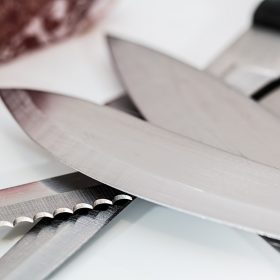So What Does “Extra Virgin” MEAN? And What Should I Do About It?
A bottle of “really good” extra-virgin olive oil is a badge of honor in the kitchen. Once you reach the milestone of having it always available, you use it for everything, right? If it’s good in some things, it must make everything better. Right?
Actually, not so much.
First, what on earth does extra-virgin mean? Isn’t that in the same realm as “a little bit pregnant”? Here’s the scoop: Those poor little olives weren’t left alone long enough to even get ripe. EXTRA-virgin olive oil is made from the first pressing of unripe olives. Yup, read it and weep for the poor little olives.
Your bottle probably also says “cold pressed”, which means no heat was used to extract the oil. This is a good thing, because heat damages the flavor.
“Wait! What? But I cook with it….” Well, stop that! The expensive flavors in your extra-virgin oil don’t survive exposure to cooking heat. Save and savor your cold-pressed extra-virgin oil for salad dressings, bread dips, and drizzling as a finishing oil.
Keep in mind that heat, light, and oxygen all damage the oil, and since you won’t be using it for everything any more, get a small bottle and keep it tightly capped in a cabinet. You can also keep it in your fridge, which will prolong its life, but you will need to let it come to room temperature in order to use it, because it will solidify in the cold.
The other problem with olive oil, one that’s talked about more often, is that it has a low smoke point. That means it will become unpleasantly smoky in your kitchen long before the stir-fry is ready or the oven-roasted veggies have caramelized.
Here are some other fun facts about extra-virgin olive oil:
1. It might be green or it might not. A green color is not an indicator of better quality.
2. It might be clear or it might not. Clarity is not an indicator of better quality. Some oils are filtered, and others are not. Cloudy is okay.
3. The oil may have some inherent heat. That’s in spiciness, not temperature. The good ones will give you a little black pepper feeling in the back of the throat.
4. French and Spanish olive oils may be a little sweeter than Italian ones.
5. No matter what kind it is, it should smell GOOD. Buttery, citrusy, grassy, welcoming. If it smells odd, off, or rancid, ditch it!
Now that you know all that, you may still be wondering what to COOK with. Here’s a list of high-smoke-point oils that don’t break down in the heat the way your extra-virgin olive will:
• Avocado Oil—has the side benefit of being really good for you
• Canola Oil—inexpensive, and low in saturated fat
• Corn Oil—inexpensive, all purpose
• Grapeseed Oil—low in saturated fat
• Sunflower Oil—good for you
• Peanut oil or Sesame Oil—if you’re looking for some toasty flavor
• Light Olive Oil—processed to lighten the flavor, it also has a fairly high smoke point
• Vegetable Oil—but who knows what’s in there?? Stick with a single-source oil from higher up in this list.
You’re welcome.





